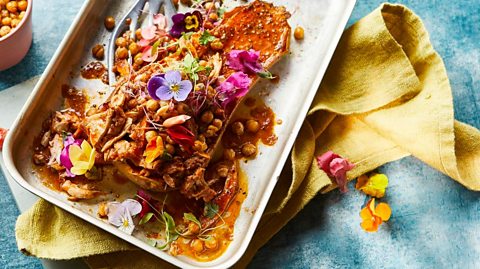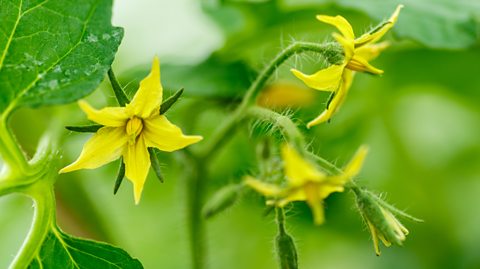7 beautiful foods to plant in your garden
Do you want to grow food in your garden without overhauling it into an allotment? Or wish you had a veg patch but don’t have the time? You can have the best of both worlds, by scattering edible plants among your borders or in pots on the patio.
These are seven expert-recommended plants to add to your edible landscape this summer. They aren’t tricky to find either, you can even buy some of these in your supermarket.
Chives (and other herbs)

Chives have a gorgeous ball-shaped flower that’s bright purple. Both the leaves and flowers are edible and can be used in dishes such as eggs royale, hearty soups and scones as well as flavouring creamy cheeses and butter.
In borders, “if the chive flowers aren’t picked they will run to seed and you’ll have clumps of chives popping up everywhere,” said mindful gardening coach, Kendall Marie Platt. Free food!
You can start them from seed, or find pots of chives in some supermarkets. Supermarket pots of rosemary and thyme will transplant into fresh compost well and carry on growing if you don't harvest too much until they are established. They like a dry sunny spot, nothing too soggy, but are fairly unfussy otherwise. There are different sorts of rosemary and more of thyme – from golden or woolly-leaved to trailing and creeping varieties with pink, white and purple flowers – if you want to seek them out from a garden centre. Just check that it's an edible variety.
These herbs are perennial and easy to grow, so a great starting point. Other unfussy herbs such as mint, lovage, sage, oregano and marjarom all have beautiful foliage and can be used in borders, too, even if they have less dramatic flowers.
Edible flowers

Viola tricolor, sometimes called heartsease, pot marigolds (calendula) and cornflowers are edible and have a long flowering period that will cheer your garden up all summer. Scattered on a salad or over a vegetable dish like Shivi's creole squash they make everything seem very chic and summery. You can also crystallise flowers to use on top of cakes and puddings. They are really easy to sow from seed, don't require any special soil conditions and common enough to find in a garden centre if it's a bit late.
Lavender is a herb often used to flavour puddings with its delicate yet recognisable floral notes. It looks as beautiful in your garden with purple flowers and green leaves as it tastes in your lavender shortbread and cakes like Paul Hollywood's lemon and lavender loaf.
Plant lavender outside from spring to early summer. Many supermarkets and shops sell lavender when it's in season, but you can also buy plants online or from garden centres. They are great placed “in a border of a path, so when you brush past you smell the lavender [and the] bees like it too,” says Horticulturist and Director of Doorstep Gardener Jonathan Ward. He advises to plant in full or partial sun and says they’re easy to care for, as they don’t need too much watering.
Chard

Chard is a leafy green vegetable that has beautiful stems, which are often white or red but different varieties show different colours: Magenta Sunset, Orange Fantasia, and for maximum colour, Bright Lights varieties produce stems in pink, orange, and a mix of gold, pink, red, white, and striped, respectively.
Chard can be used like spinach and it also tastes slightly similar. Make your meals vibrant by popping it in Nigella Lawson's chard pasta, Rick Stein's Greek-style bean casserole and even with baked potatoes and beans.
Sow seeds directly into rich, fertile soil in a sunny spot from February to October. Chard is a "cut and come again" plant, that will keep producing new leaves as you cut the big ones off to use. “A spring sowing and another in the summer will provide you with chard for the whole growing season,” says Platt. They can also be grown in pots, but Platt advises these should be at least 25cm deep.
Nasturtiums
Nasturtiums are more than just pretty flowers. You could create a complete salad out of the nasturtium plant using the young, green leaves, red and yellow petals and seed pods. Its name literally means “nose twister” because of the peppery kick the leaves have when eaten. Tom Kerridge makes a fantastic nasturtium pesto too. The petals are sweeter and less peppery than the leaves and sit beautifully on grain or green salads. When the flowers have finished the seed pods of the nasturtium can be pickled, and taste a little like capers.
Sow seeds in the ground or in a container, including a hanging basket from late spring to early summer. Plant in full sun or partial shade, according to Ward.
Globe artichoke

Globe artichokes make a stunning architectural feature in your garden. They have an eventual height of around 1-1.5 meters, so are perfect for "drawing your eye to the back of a border," says Platt. Some varieties, such as Purple Globe also bring a splash of colour. If the globes are not harvested, they will flower with a bright-purple fluffy tuft.
Watch our video to see how to prepare an artichoke. The process is a labour of love, but worth it for artichoke-lovers. Boil the artichokes for 20 minutes, or until soft at the centre and eat simply with melted butter, or follow these recipes to make a summery artichoke risotto or artichoke pasta.
You can grow these from seed between February to March but can also buy garden-ready plug plants from April onwards. The artichoke plant is a perennial, meaning that it will come back every year to bring you a delicious crop.
Strawberries
You can’t talk about beautiful edible plants without involving strawberries. Not only are the leaves very pretty, but the small white flowers, or pink depending on the variety, are eye-catching with bright red strawberries are as beautiful as they are delicious.
You might have your own favourite way to eat strawberries, perhaps just with cream, but they are classically eaten with Eton mess, made into strawberry jam or treat yourself to a strawberry mojito. But if you only have space for a few plants, just eat them fresh off the plant, warmed by the sun.
Buy them as young plants from April onwards. Mara des Bois is a small but flavourful variety that keeps producing fruit all summer. They’re “great for growing in a pot or hanging basket as well as in the ground, but they love full sun to get the best crop,” said Platt. Strawberry plants will come back every year and will even spread through your borders by sending out ‘runners’ to make baby strawberry plants. Protect your precious fruit from slugs and squirrels, because everyone will want to eat them.
Tomatoes

You might often buy tomatoes from a shop, but they look amazing growing in your garden. They produce beautiful yellow flowers before ripening their fruit, although these are not edible themselves. There are a number of visually interesting tomato varieties you can pick. Pink Tiger “has edible lemon shaped fruits with dark pink and orange striped skin”, said Platt. Other varieties are trailing, such as Tumbling Tom, which produces a cascade of red or yellow cherry tomatoes in a hanging basket.
Fresh tomatoes are versatile and often cooked in sauces, but when picked from the garden, they're best eaten raw to get the most of the fresh, sweet flavour. Pair with mozarella and basil, feta and lentils or pop in Panzanella.
"Tomatoes are happy planted in the ground or in a pot, outside or in a greenhouse”, said Platt. They’ll need to be staked for support as they can grow too tall to hold themselves up. Buy young seedlings to put outside between May – June, after any risk of frost has passed. You can even plant the seeds from inside your store-bought salad, cherry or plum tomato, but it is best to sow these in early spring inside.
When not to eat your plants
If you are ever in doubt as to whether a plant or flower is edible, don’t eat it. Some flowers and plants are deadly. If you have pollen allergies, it might be best to avoid eating flowers altogether. If you’re eating what you plant in your garden, avoid using pesticides and don’t pick mouldy or discoloured flowers or produce.